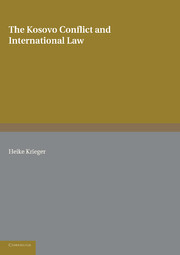Book contents
- Frontmatter
- Contents
- Map
- Preface
- Chronology
- Introduction
- Chapter 1 Kosovo's Status in Yugoslavia before 1999
- Chapter 2 Development of the Human Rights Situation pages 14 to 40
- Chapter 2 Development of the Human Rights Situation pages 41 to 64
- Chapter 2 Development of the Human Rights Situation pages 65 to 90
- Chapter 2 Development of the Human Rights Situation pages 90 to 114
- Chapter 3 Diplomatic Efforts for the Settlement of the Crisis pages 115 to 146
- Chapter 3 Diplomatic Efforts for the Settlement of the Crisis pages 147 to 187
- Chapter 3 Diplomatic Efforts for the Settlement of the Crisis pages 187 to 217
- Chapter 3 Diplomatic Efforts for the Settlement of the Crisis pages 218 to 253
- Chapter 3 Diplomatic Efforts for the Settlement of the Crisis pages 253 to 286
- Chapter 4 Military Action against Yugoslavia pages 287 to 313
- Chapter 4 Military Action against Yugoslavia pages 314 to 352
- Chapter 5 Settlement of the Crisis
- Chapter 6 Statement by NATO Memeber States
- Chapter 7 International Reactions to the Crisis pages 424 to 460
- Chapter 7 International Reactions to the Crisis pages 461 to 499
- Chapter 8 Court Action with regard to the Kosovo Crisis
- Chapter 9 Implementation of the Principles for a Political Solution of the Conflict
- Chronological List of Documents
- Select Bibliography
- Index
Chapter 1 - Kosovo's Status in Yugoslavia before 1999
Published online by Cambridge University Press: 05 July 2014
- Frontmatter
- Contents
- Map
- Preface
- Chronology
- Introduction
- Chapter 1 Kosovo's Status in Yugoslavia before 1999
- Chapter 2 Development of the Human Rights Situation pages 14 to 40
- Chapter 2 Development of the Human Rights Situation pages 41 to 64
- Chapter 2 Development of the Human Rights Situation pages 65 to 90
- Chapter 2 Development of the Human Rights Situation pages 90 to 114
- Chapter 3 Diplomatic Efforts for the Settlement of the Crisis pages 115 to 146
- Chapter 3 Diplomatic Efforts for the Settlement of the Crisis pages 147 to 187
- Chapter 3 Diplomatic Efforts for the Settlement of the Crisis pages 187 to 217
- Chapter 3 Diplomatic Efforts for the Settlement of the Crisis pages 218 to 253
- Chapter 3 Diplomatic Efforts for the Settlement of the Crisis pages 253 to 286
- Chapter 4 Military Action against Yugoslavia pages 287 to 313
- Chapter 4 Military Action against Yugoslavia pages 314 to 352
- Chapter 5 Settlement of the Crisis
- Chapter 6 Statement by NATO Memeber States
- Chapter 7 International Reactions to the Crisis pages 424 to 460
- Chapter 7 International Reactions to the Crisis pages 461 to 499
- Chapter 8 Court Action with regard to the Kosovo Crisis
- Chapter 9 Implementation of the Principles for a Political Solution of the Conflict
- Chronological List of Documents
- Select Bibliography
- Index
Summary
The 1974 Yugoslav Constitution conferred a status that was a near equivalent of the six republics (Bosnia and Herzegovina, Croatia, Macedonia, Montenegro, Serbia, Slovenia) to the autonomous provinces of Kosovo and Vojvodina (document no. 1). The considerable changes already made by amendments in 1971 were incorporated in the constitution. These changes had created a status for the autonomous provinces equal with the republics in most forms of economic decision-making and even in some areas of foreign policy. The autonomous provinces each had their own central bank and separate police, educational systems, a judiciary, a provincial assembly and representation in the Serbian parliament. The constitution expressly provided for full equality between the republics and autonomous provinces in regard to their participation in the federation, by determining that federal decisions were to be made “according to the principles of agreement among the republics and autonomous provinces.” Both provinces also had distinct representation in each federal organ. The federal presidency, as a collective body, was composed of two representatives of each republic and one from each autonomous province. Their leaders thus had separate membership of the rotating collective presidency which took over after the death of Tito. Like all republics, the Kosovo Assembly had the power to veto any amendment to the federal constitution. Moreover, the 1974 constitution added the provinces' right to issue their own constitution. The Yugoslav government, however, did not grant the autonomous provinces the right to secede, which the republics enjoyed.
- Type
- Chapter
- Information
- The Kosovo Conflict and International LawAn Analytical Documentation 1974–1999, pp. 1 - 13Publisher: Cambridge University PressPrint publication year: 2001

